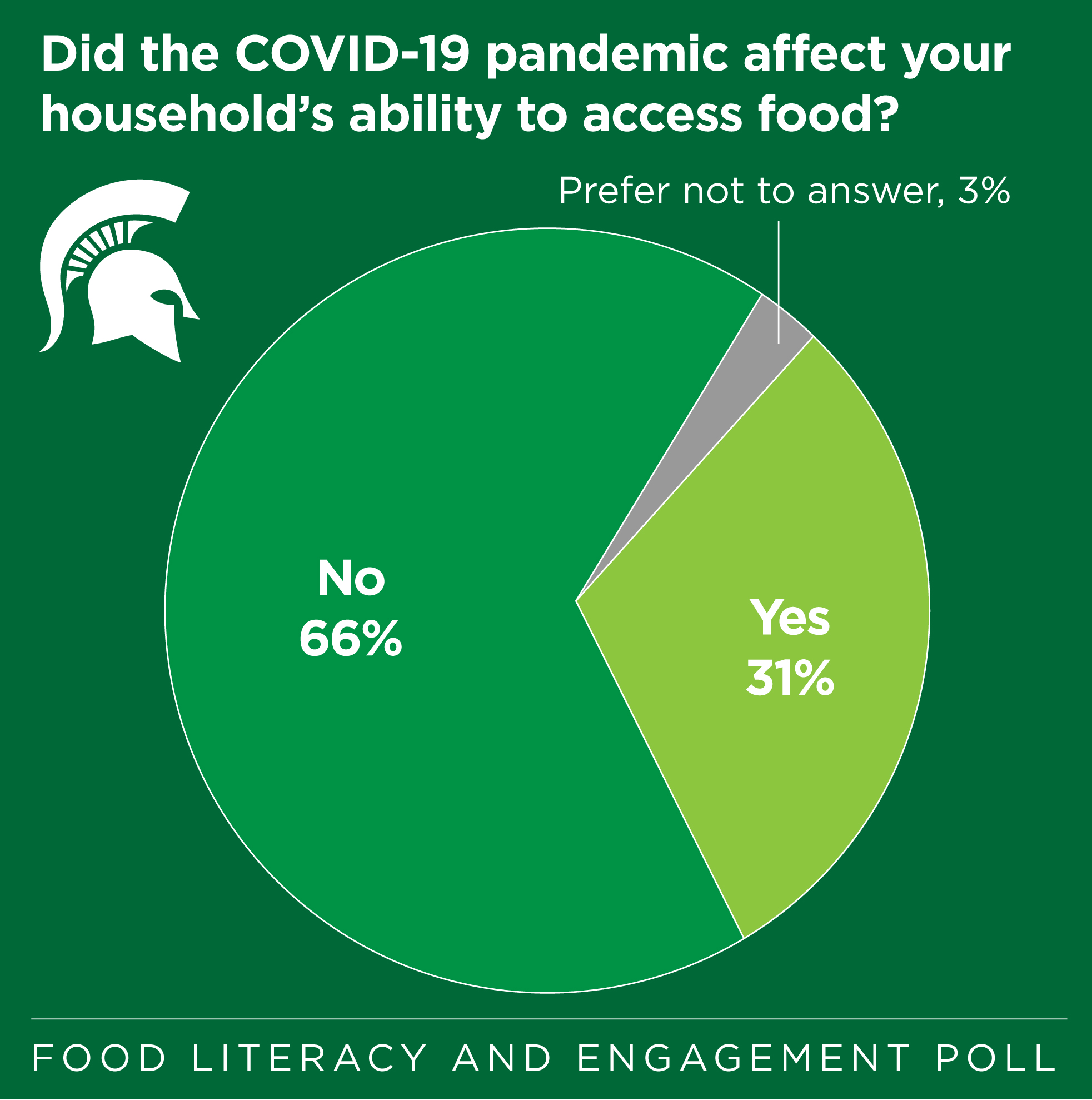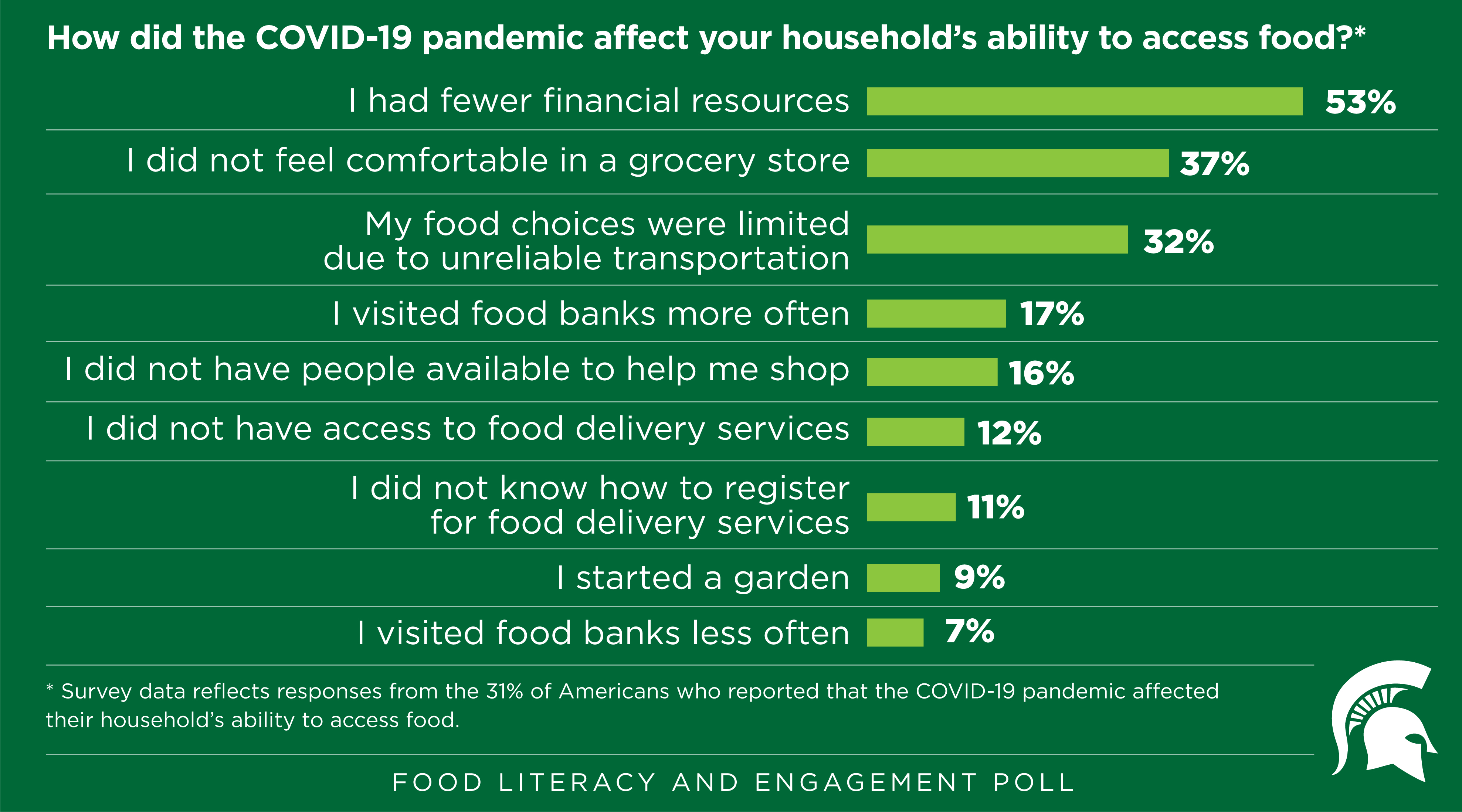Latest MSU Food Literacy and Engagement Poll reveals COVID-19 has impacted food access for nearly one-third of Americans
Half of the participants reported the pandemic has changed their food choices.
 EAST LANSING, Mich. – For many Americans, the COVID-19 pandemic has affected food security and purchasing behavior. The eighth wave of the Michigan State University (MSU) Food Literacy and Engagement Poll sampled 2,002 Americans to explore how COVID-19 has affected food choices and access. About one-third (31%) of Americans say the pandemic has affected their household’s ability to access food. Among this group, over half (53%) reported fewer financial resources. Thirty-seven percent did not feel comfortable shopping at the grocery store and 32% felt their food choices were more limited because they did not have reliable transportation. Nearly one-fifth (17%) visited food banks more often.
EAST LANSING, Mich. – For many Americans, the COVID-19 pandemic has affected food security and purchasing behavior. The eighth wave of the Michigan State University (MSU) Food Literacy and Engagement Poll sampled 2,002 Americans to explore how COVID-19 has affected food choices and access. About one-third (31%) of Americans say the pandemic has affected their household’s ability to access food. Among this group, over half (53%) reported fewer financial resources. Thirty-seven percent did not feel comfortable shopping at the grocery store and 32% felt their food choices were more limited because they did not have reliable transportation. Nearly one-fifth (17%) visited food banks more often.
“COVID-19 laid bare vulnerabilities that already existed in the food system,” said Sheril Kirshenbaum, co-director of the biannual survey. “Unfortunately, many families already struggling with food insecurity were strained even further as others found themselves at food banks for the first time.”
Among respondents who said they had fewer financial resources, three-quarters (74%) chose different brands of food. Nearly half (47%), consumed less food and roughly one-third (31%) accessed government programs such as the Supplemental Nutrition Assistance Program (SNAP).
“The pandemic presented yet another challenge to people obtaining nutritious and affordable diets," said Doug Buhler, co-director of the Poll. "On one hand, we should be pleased that the basic system stayed intact, but the pandemic also exposed vulnerabilities that need to be addressed."

Among the half of respondents (50%) that reported the pandemic has changed the way they purchase and store food, 51% seek out foods with a long shelf life, 50% store more food at home and 48% take fewer trips to the grocery store. Twenty-seven percent are more aware of the food they waste and 23% began using a grocery delivery service.
The MSU survey also explored whether receiving a COVID-19 vaccine influenced food access and behavior. Among the 69% of respondents who had been vaccinated at the time of the survey, over two-thirds (67%) say they now visit the grocery more frequently than prior to receiving the shot. One third (33%) spend more time in the grocery store and 29% report they can more easily access and transport groceries. Just 15% stopped wearing masks where they are not required.
For more information about the MSU Food Literacy and Engagement Poll, including past results, click here.
Data from the MSU Food Literacy and Engagement Poll were weighted using U.S. Census Bureau figures, to ensure the sample's composition reflects the actual U.S. population. Launched in 2017, the poll is supported by MSU AgBioResearch. The survey, conducted twice per year, is intended to provide an objective, authoritative look at consumer attitudes and perspectives on key food issues, and is designed to help inform national discussion, business planning and policy development.



 Print
Print Email
Email











